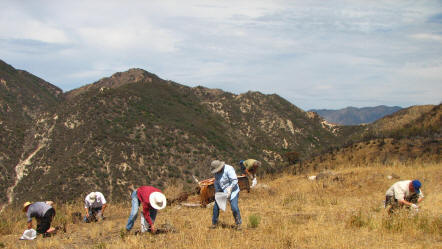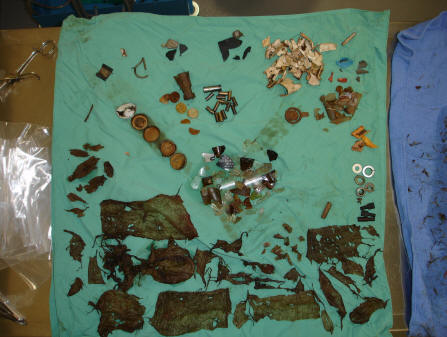|
July 14, 2007
FORESTWATCH VOLUNTEERS
REMOVE
150 POUNDS OF MICROTRASH TO
PROTECT NEARBY CONDORS
Condor
Biologists Fear Young Condors Could Ingest Glass, Bottle Caps,
Wires, Screws, and Other Small Trash From Whitaker Peak Near
Sespe Wilderness
Whitaker Peak,
Calif. - Today, a team of fourteen ForestWatch volunteers
converged at Whitaker Peak, an area adjacent to the Sespe
Wilderness near the Ventura/LA county line. The site is
frequented by an adult California condor. Unfortunately, the
area is also littered with small bits of trash, which the
curious condor picks up and brings to her nearby nest,
threatening the young condor inside.
By the end of
the day, after braving 90-plus degree temperatures, we had
removed more than 150 pounds of debris! We’ll continue to
monitor this site and schedule additional clean-ups as needed.
Thanks to all of the volunteers for your support!

ForestWatch volunteers pick up microtrash to protect
endangered California condors nesting nearby.
Earlier this year,
condor biologists at the U.S. Fish and Wildlife Service
became concerned about large amounts of trash on Whitake Peak. Several
condors have died or required surgery after ingesting these
small trash fragments.
Microtrash is a
term used to describe small bits of debris like bottle caps,
rags, screws, bolts, wires, glass, and other materials found in
condor habitat. Condors, curious by nature, are attracted to
microtrash, and often ingest it or bring it back to their nests,
where condor chicks swallow the small pieces. Microtrash is not
digestible and is fatal unless it's surgically removed.

Stomach contents of a
California condor. Photo courtesy USFWS.
Microtrash is one of the
leading threats to the recovery of the California condor. It's
been the cause of nest failure for three of 11 chicks hatched in
southern California previous to this year. Another chick was
recently removed from its nest to have the trash surgically
removed.
The problem is particularly troublesome
for one condor pair nesting at the nearby Hopper Mountain
National Wildlife Refuge. This pair had two previous nestings in
which their chick was full of trash. The female wears an
electronic transmitter, and condor biologists know that she
frequents the Whitaker Peak area. They suspect that this site is
where she picks up much of this trash.

A radiograph showing microtrash
ingested by a condor.
Photo courtesy USFWS.
|